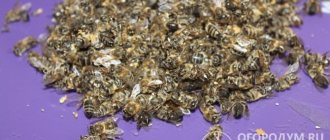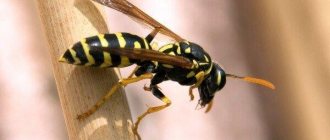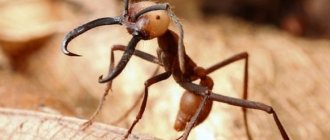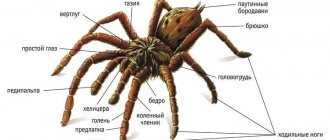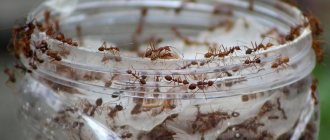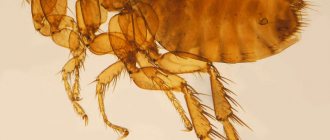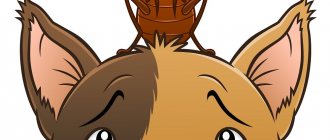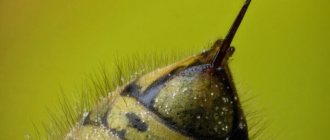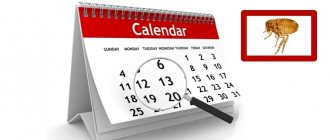What they look like
Entomologists know very well what hornets look like and will not confuse them with other insects.
The large wasp differs from other members of the family in the following characteristics:
- The head is larger, with a wide upper part. These Hymenoptera have 2 compound eyes and 3 simple ocelli.
- The head color varies between black, yellowish, orange or reddish brown interspersed with yellow spots. There are black-brown antennae on the head. The number of segments differs in females and males. The color of the jaw is black, brown or orange-yellow.
- The abdomen is rounded. In the area of its articulation with the chest, a beautiful thin waist line is visualized. In its color palette it resembles the common wasp, but the stripes are not so pronounced.
- At the end of the abdomen of working females and the uterus there is an ovipositor, which is a sting. If the insect manages to live calmly, then the sting is retracted into the abdomen and is not visualized. At its base there is a poisonous gland filled with a toxic substance. The sting is straight, smooth and has no jagged edges. A hornet can live with a used sting for a long time.
- Set of lower limbs - 3 pairs of legs, black, brown or yellow. Each limb includes a coxa, an acetabular ring, a proximal part, a tibia ending in a spur, and a tarsus.
The insect's wings are transparent with large cells . They are presented in 2 pairs: the front ones are large, the rear ones are small. While the hornet manages to live quietly, its front wings are connected together along the back.
During flight, the leading edge of the small wings is attached to the trailing edge of the large ones using special hooks. As a result, both right and both left wings create one aircraft.
Lifestyle of the giant scolia
Scolia giant or Scolia spotted
The largest wasp in the world is a primitive creature that leads a solitary lifestyle. It is active during the day and burrows into the forest floor and grass at night. Adults feed on fruit juices and flower nectar, but protein food is required to feed the larvae.
The female lays eggs directly into the body of the victim or feeds the larvae on her own, hunting large beetles and their offspring - rhinoceroses, some species of beetles. Attacks the victim, paralyzing with poison. In this state, the beetle does not die, but is immobilized. This allows you to keep food fresh for a long time. It takes Scolia wasp larvae 12 days to eat the beetle. As a result, only wings remain from the victim.
In most cases, the female burrows into the ground, finds the larva, stings, and lays an egg in the body. After some time, a parasitic larva appears, which eats the insides of the victim and, at the end of its development, pupates. It spends the winter in this state. In the spring, a young individual appears. The large wasp is active in May and June.
Interesting!
Unlike social wasps, representatives of large scolia do not communicate with each other, do not give each other signs or signals. The insect does not build complex nests, and the hunting process is hidden from everyone, since it occurs underground. The most famous types of skolia are steppe and giant.
What do they eat?
What hornets eat is the following::
- sugary plant juice;
- juice of ripe soft fruits (peach, pear, apple);
- berries (raspberries, blackberries, strawberries);
- sugary secretions from aphids;
- bee products.
These insects are excellent hunters. Their victims include grasshoppers, spiders, and dragonflies. They can also live by feeding on flies, small locusts, caterpillars and close relatives - bees.
Prey is killed with powerful jaws and stings, then moistened with saliva and chewed to form a slurry. But the adult does not swallow this portion of food; she feeds it to the hungry larvae during their dynamic growth.
In 24 hours, a large colony of Hymenoptera feeds its larvae up to 500 g of processed other insects. Some hornets, in addition to catching live prey, also constantly search for dead insects. To live, they do not disdain fish or meat, which people throw away as waste. They actively feed their offspring with all this.
Wasp rider: where it lives
The ichneumon wasp is divided into several categories depending on where it lives, what it eats, and its significance for humans.
For example, chalcides are representatives of the genus that destroy plant pests. Evanioid ichneumonids are also distinguished, which are used as a place for laying eggs of cockroaches, wasps and sawflies. According to the method of parasitism, insects can be divided into three groups:
- Ectoparasites.
When attacking, they actively use toxic poison and lay eggs on the surface of the body of another individual. - Endoparasites.
They choose the internal cavity of the victim as a place for laying. The emerging larvae use the internal tissues of the victim for food. - Superparasites.
They infect insects that lead a similar parasitic lifestyle.
The largest number of adult individuals can be found in places with high humidity - near a pond, lake, river and other bodies of water. They hide in thickets and bushes, in the crown of trees. In search of prey, riders descend into the ground.
Kinds
In addition to the common one, the following varieties of hornets are found::
- Deplorable. Endemic to the Philippine Islands. The color is brown or black, with white stripes visible on the wide abdomen. The clypeus is orange-yellow. This insect produces highly toxic poison, so its bite is very dangerous for humans or animals.
- Oriental. The body is red-brown in color, with a wide yellow-white stripe on the abdomen. It contains the pigment xanthopterin, which allows insects to convert absorbed sunlight into electricity. This type of insect is able to live in dry and hot climates.
- Black. The abdomen and chest are black-brown, the wings are brownish. This species is listed in the Red Book of the Chita Region. The insect almost never builds its own nests, parasitizing in the nests of hornets of other species.
One of the largest is the Japanese hornet . In the land of the rising sun it is often called the “sparrow-bee.” This is a very large insect, the body length of which is 4 cm, and the wingspan reaches 6 cm. Its large head is yellow in color. The abdomen is dark brown with yellow stripes.
The sting of the Japanese hornet wasp reaches a length of 6.2 mm. An insect bite is very painful. The poison contains nerve toxins. According to statistics, about 40 people die every year from attacks by such a hornet in Japan.
Symptoms of a hornet sting
Signs of intoxication with insect venom affect the problem area directly, as well as the entire body as a whole. Wherein:
- the bitten area swells;
- the reaction to the poison spreads quite quickly, affecting other areas and an increasingly large area;
- In the place where the hornet's sting penetrated, severe pain is felt.
At the same time, the bite provokes an increase in heart rate. There is a sharp change in blood pressure levels.
If you are prone to allergic reactions, other symptoms of a hornet sting develop:
- constant nausea and productive vomiting;
- severe cooling of the extremities;
- rise in body temperature;
- complete or partial loss of consciousness, fainting may follow one after another;
- less often, there is a change in the color of the skin of the neck, eyelids or the entire face, which becomes blue;
- development of attacks of suffocation, swelling of soft tissues.
As a result of a hornet sting, extensive red spots appear on the body. Severe peeling of the skin may occur.
Reproduction
With the arrival of warm days, the female hornet is actively looking for a place to lay eggs. She is ready to live and start a family only in suitable conditions, so in her search she flies over large areas. Having found a convenient corner, she immediately begins to create her home.
Each egg has its own sector. After 2-3 days, small hornet larvae hatch from them. They chew the lid and climb out. The offspring are born long before the winter period, manage to get stronger and continue the work that was started by the uterus.
After fertilization, the males die, followed by the old queen, and after some time the unfertilized individuals lose their lives. Those who have been fertilized overwinter, continue to live and then create their own nest. In the hornet family, reproduction is successful.
This is possible because the colonies are well organized. Everything happens harmoniously, thanks to the division of responsibilities. Some feed, build nests, while other members of the family raise offspring.
Habitat of the Great Scolia
There are about 1 thousand species of Scolia in the world. About 25 live in the CIS countries. Three subspecies are distinguished in the world: Megascolia maculata bischoffi, Megascolia maculata flavifrons, Megascolia maculata maculata. The main part of these insects lives in tropical and subtropical zones. The huge wasp lives in North America, Africa, Southern Europe, the Middle East, Turkey, Crimea, Central Asia, and Russia.
Scolia the giant lives in forest, forest-steppe, and mountainous areas. It rises in the mountains to a height of 1150 m above sea level.
On a note!
The spotted wasp lives in areas where there are large lamellar beetles, since their larvae are needed for laying eggs of the wasp family.
Building a nest
The place for the hornets' nest must be protected from bad weather and drafts. In nature, hornets often build nests in tree hollows. If their number decreases, then the queen begins to look for a home closer to the person.
Sometimes they choose birdhouses, fill them completely with tiers of honeycombs and go on new searches. Sometimes hornets hang a nest on tree branches, hide it in rocks, holes or in the attics of human houses.
To make a nest, hornets use a material resembling cardboard . When expanding the structure, they lead tiers (5-7 pieces) from top to bottom. Each honeycomb plate has up to 500 cells. When viewed from the outside, the nest resembles a cocoon. The shape changes at different stages of construction. The protective walls reach 2-3 cm. The most common color of cocoons is brown.
Where does the sea wasp live?
Photo: Australian sea wasp
The transparent predator inhabits coastal waters off the coast of northern Australia (from Gladstone in the east to Exmouth in the west), New Guinea and the islands of Indonesia, spreading north to the coasts of Vietnam and the Philippines.
Typically, these jellyfish do not swim into inland waters and prefer ocean space, although they stay shallow - in a layer of water up to 5 m deep and not far from the shore. They choose areas with a clean, usually sandy bottom and avoid algae thickets where their fishing gear can get tangled.
Such places are no less attractive to swimmers, surfers and scuba diving enthusiasts, which leads to clashes and casualties on both sides. Only during storms do jellyfish move away from the shore to deep and calm places to avoid getting caught in the surf.
To breed, sea wasps enter fresher river mouths and bays with mangroves. Here they spend their lives in the polyp stage, attached to underwater rocks. But having reached the jellyfish stage, young wasps again rush into the open ocean.
Now you know where the sea wasp is found. Let's see what the poisonous jellyfish eats.
Role in nature
Entomologists explain why the hornet is needed in nature. They are predators and destroy harmful insects and their larvae. Hornets play a regulatory role in wildlife. If they are completely destroyed, this will affect the balance of the ecosystem.
On the other hand, these predators harm beekeepers by eating bees. In addition, they damage fruits, reducing yields. If a person comes close to hornet nests, they may attack. These insects sting very painfully, causing allergic reactions and inflammation.
The benefits and harms of insects
Hornets bring undoubted benefits, participating, like all other living beings, in food chains, occupying a certain place in nature. In particular, they destroy forest and garden pests, such as aphids.
In Germany, Austria, as well as in other countries, European hornets have been protected since January 1, 1987; their destruction is prohibited by law, and the fine for destroying a nest in Germany is up to 50,000 euros.
Hornets can become pests when they start preying on bees. If they only catch old and sick individuals, then there is even a benefit. However, some species, for example, the Asian giant hornet and the oriental hornet, cause serious damage to apiaries.
The main disadvantage of these insects is considered to be painful and, sometimes, very dangerous bites.
Hornet sting
Hornet venom contains a lot of acetylcholine, which increases pain, so their stings are more unpleasant than wasp stings. The affected area may also become swollen and red.
However, pain and swelling are not the worst consequences. Sometimes allergic reactions develop, including rapid ones (anaphylactic shock). If a person is not given medical assistance, there is a risk of death. Such cases occur every year. As a rule, severe reactions occur in people prone to allergies, as well as in children. But multiple bites are dangerous for everyone. Actions in case of a hornet bite:
- Try to immediately take an antihistamine (for example, Suprastin). Even if you've never had allergies, it's better to be on the safe side.
- You can try to suck out the poison from the wound, but this must be done immediately after the bite, before the poison is absorbed.
- A cold compress should be applied to the bitten area to stop the swelling.
- You can smear the bite with a gel like Fenistil.
If your health sharply worsens after the bite, contact an ambulance immediately. Problems may not appear immediately, but within 24 hours after the incident. Therefore, you need to monitor your well-being and be prepared to seek medical help.
Video: what happens if a hornet bites you
Bullet Ant: 4.0
The bullet ant has the most painful sting of any insect, and some people claim that its sting causes the worst pain known to man. Belonging to the genus parponera clavata, these giant ants are reddish-black in color, as if warning of danger. The pain from this ant's sting has been compared to being shot by a bullet, and Schmidt describes the sting as pure intense pain, comparable to walking barefoot on burning coals, or driving 3-inch nails into your heels. The Schmidt Pain Index gives the bullet ant's sting an incredible 4.0+, as the intense pain can last up to 24 hours. Definitely, this ant can be called the insect with the most painful bite.
Lifestyle
Like almost all Hymenoptera, hornets are collective insects. They live in large colonies in self-built cellular structures. Just like wasps and bees, only in smaller numbers. The hornets' nest is also larger in size than the wasps' nest.
Typically, these large wasps prefer to use hollow trees, attics of houses, occupied beehives, as well as animal holes and caves as shelters for their homes.
These wasps build their homes in several tiers, horizontally. The material for construction is chewed pieces of wood bark, most often birch, moistened with saliva. Therefore, such papyrus material is not white, but rather a brownish tint, while to the touch it resembles thin paper, something like paper foil, so to speak.
In created nests, hornets maintain a strict hierarchical system of relationships. At the head of the colony is the queen, which produces hundreds of eggs. She is protected by the rest of the family. All actions of its members are aimed at preserving the queen, and therefore the colony itself.
Each insect is like a cog in the system. Workers spend all their active time searching for food for the queen and the younger generation in the form of larvae. Among them there are also “cleaners” who perform the functions of “nannies” for the larvae and also clean the nest.
In fact, during the day, only the female, larvae and a number of workers and “nurses” are in the nest to maintain the colony’s defenses. The rest of the family visits the nest only at night to sleep. The hornets' nest is somewhat reminiscent of a feudal castle, with a queen, soldiers, artisans and servants. Just a little simplified.
Striped fly
Temnostoma wasp is a large fly from the hoverfly family, very similar to a wasp. On a long body (up to 18 mm) there are 2 transparent wings. In the center of the dark head there is a shiny stripe and reddish mustache. There are thin golden hairs on the chest and scutum. The oval abdomen is covered with transverse yellow-black lines.
Attention! Sometimes the marks merge, leaving a narrow brown spot.
Wasp-like flies live in deciduous forests where there is a lot of rotting vegetation. Found in river valleys and mountains. Temnostoma axialis is common in:
- Europe;
- Asia;
- North Africa;
- Greenland;
- America.
External differences
Externally, these insects are very similar, but their body size differs.
The body length of the queen hornet reaches 4-5 cm. Working individuals and males are shorter. The common wasp is of medium size compared to other hymenoptera. The workers reach 1.2-1.4 cm in length, the female - 1.8 cm. How a wasp differs from a hornet also becomes clear if you pay attention to their color and other features. Small wasps have no shades of brown on their bodies: their predominant colors are yellow and black
Their large relatives always have a brown tint, mainly on the cephalothorax.
Both members of the family have a characteristic thin waist, powerful jaws and large organs of vision. But their head size and shape are noticeably different. Hornets have an almost round head with a wide nape. Wasps' heads are small in size and slightly narrowed at the base.
Hover flies
Hoverflies, also known as syrphids, are a large family with about 6,000 species. Some of them look more like bees, others like wasps, and others like bumblebees. They live everywhere, with the exception of Antarctica, desert areas and tundra. They got their name because of the characteristic sound made by their wings.
Interesting! Syrphidologists study hoverflies. They even hold special symposiums dedicated to fly research.
A striped insect, similar to a wasp, absolutely harmless to humans. It can often be found in plantings of dill, carrots, parsley, and flowering plants in the garden. Adult hoverflies feed exclusively on flower nectar and pollen and occupy an honorable place among pollinating insects
Lifestyle, nutrition, reproduction
Adult insects are very maneuverable and can change direction to the exact opposite very abruptly. Thanks to the rapid movement of its wings, the fly often hovers in one place and seems to hover in the air above the flowers, as if choosing which one has the most delicacy.
The larvae are voracious, and the older they get, the more and more actively they eat. They feed mainly on small insect pests - caterpillars, psyllids, spider mites, small butterflies and aphids. They literally suck the latter alive. One syrphid larva can suck up to 200 aphids in one day, and one can imagine how a whole brood of such larvae will benefit the garden. It is on plants affected by aphids that one can often notice a cluster of syrphid larvae. In addition, the larvae can be localized in the nests of other insects, rotten rotting wood, and on large plants.
In the larval stage, flies hoverflies and overwinter. In the spring, pupae appear from them, and by the end of June, young adults appear, starting their years already in July.
During the period of courtship with females, males hover in the air above them and make a sound similar to gurgling. A similar, but slightly different sound can be heard from syrphids at other times, hence their popular name - hoverflies. Mating of these flies can occur right in the air. Also, while hovering, males protect their territory, driving away rivals.
Lifestyle
The rules for the existence of hornets in nature are very similar to those of bees and ants.
In order to survive during the cold winter and give birth to offspring every year, insects have to sacrifice someone and something. They sacrifice males, who die soon after mating. This way resources are not wasted on already “useless” individuals. After all, in the hornet family, the females are the main ones. Therefore, they must prepare well for hibernation, survive it, and in the spring become the founder of a new colony. The uterus needs a large amount of protein to produce eggs and develop ovaries. In order to successfully overwinter, it eats very richly and accumulates a fat body.
Mating Features
The greatest activity in the hornet family is observed at the end of the warm period of the year, namely the end of August and the beginning of September. By this period, individuals of both sexes become adults. They all leave their home, swarm and mate. Thus, mating occurs before the onset of cold weather. Female hornets spend the winter pregnant.
Males die soon after mating. Females lead a solitary lifestyle. They feed heavily, and between meals they fly around the nearby territory in search of a safe place for winter shelter. Overwintering of a pregnant female hornet, which falls into suspended animation, is possible only in a secluded place where enemies and cold winds will not find her.
Wintering conditions
Crevices in rocks, tree hollows, shelters under stones and fallen trunks, and small cavities on the outside of unheated buildings or houses are well suited for this. There is no need to be afraid that the female will hide inside a human house. There's a good reason for this. When cold weather sets in, when the air temperature drops below 0C, all water freezes.
But the water in the hornets does not freeze. This is due to the fact that in the body of insects, water is replaced by glycerol. It does not freeze, but it slows down all life processes. This way, the glycerin cannot turn into ice and rupture the insect cells. If the hornet warms up prematurely, it will die during the next cold snap.
When the female hides for the winter in a heated human house, the warm air temperature will contribute to her premature awakening and the natural need to build a nest. If she manages to hide in a house from human eyes, then it will be very difficult for her to look for material to build the honeycomb of her “house”.
When she manages to build a nest, she will not be able to find enough food in the house to feed her offspring. Thus, she will doom him to certain death. Therefore, female hornets do not choose heated human houses for wintering.
A lot of female hornets die during harsh winters with little snow, as well as in the presence of winter thaws. If the female does not manage to hide well, she will become prey to various birds or small predators. Therefore, a significant number of hornets do not survive until spring.
Spring chores
The female hornet wakes up when the air temperature warms up to +15C. Young pregnant insects that wake up begin to actively hunt so that the embryos can develop into full-fledged eggs. In addition, the young female is looking for a suitable place to build her nest.
Help with a bite.
Old females also wake up, but they do not look for a place to build a nest. They scatter around the surrounding area. When the first cold days arrive, they stop their activity and freeze. As a rule, they die before they reach their second wintering. After a nest site has been found, the young female builds the first comb and lays her eggs there.
Only worker hornets emerge from the first eggs. The female must raise them. Then they take the baton into their own hands. Working individuals independently complete the nest and feed the larvae from later eggs. Already from these larvae males and females will grow. They will begin a new cycle in August. The lifespan of worker insects is only three to four weeks.
If you meet a hornet in early spring, it is most likely a pregnant female busy with procreation. She doesn't specifically touch people, but she's not afraid of them either. The female is not dangerous to you. She has no time to threaten anyone, because she has many more important things to do. Don't touch her. Let her reproduce her offspring.
OUR READERS RECOMMEND!
To get rid of insects, our readers recommend the Pest-Reject repeller
. The operation of the device is based on the technology of electromagnetic pulses and ultrasonic waves! Absolutely safe, environmentally friendly product for humans and pets. Read more here...
